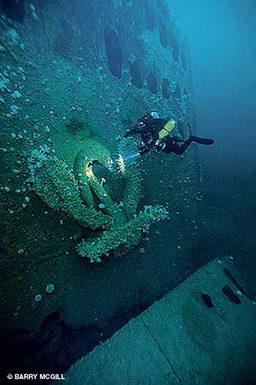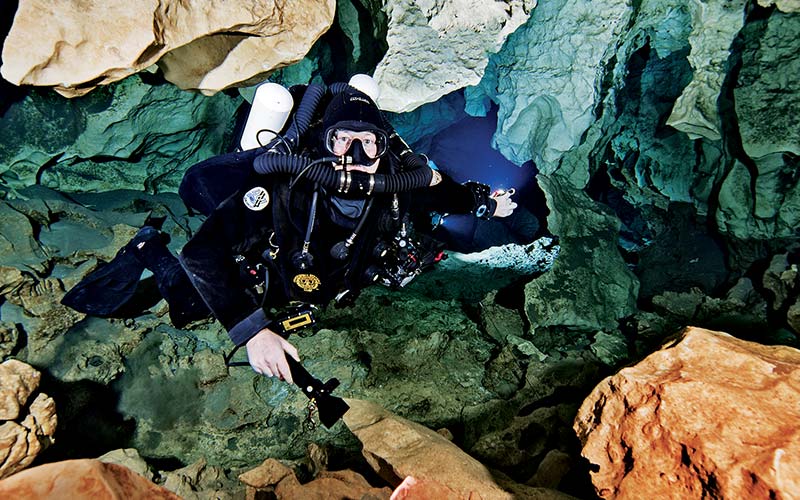Hometown: Fredericksburg, Va.
Years Diving: 24
Favorite Destination: The next mystery wreck!
Why I’m a DAN Member: I tend to play in the deeper end of the pool and in some fairly remote areas of the world, and I recognize that the costs of evacuation and medical treatment can financially bury an unprepared individual. Plus it’s great to have access to the wealth of medical expertise and information that is presented in the pages of Alert Diver.
Michael Barnette is a marine biologist whose passion for the underwater world spills over into every aspect of his life. In addition to traveling the world protecting sea turtles for NOAA, Barnette is an avid underwater photographer, historian and author. A member of The Explorers Club and founder of the Association of Underwater Explorers (AUE), he has been active in the identification of dozens of shipwrecks as well as a unique deep-water coral habitat in the Gulf of Mexico.
AD: Mike, you perform inspections of turtle excluder devices used throughout the world. What brought you into the field of marine biology?
Barnette: I have always been fascinated with the water and the ocean in particular. Like many other kids, I was enthralled by television documentaries about underwater exploration and marine biology such as The Undersea World of Jacques Cousteau and The Living Planet, narrated by the iconic David Attenborough. I suppose I was fortunate, as I always knew I wanted to be a marine biologist from an early age.

AD: You have identified many shipwrecks in your career. What is the first step you take when beginning a new project?
Barnette: Research, research and then more research; a lot of progress is achieved hunting through shipping registers and old newspaper articles. That probably counts for more than blind luck while diving. I try to learn as much as I can about a new site from those who have fished and dived it previously, and then I go to my files to draft a list of potential suspects. Over the years I have collected thousands of archival news articles, historical ship images and other records that can help aid in the identification of a wreck. Sometimes I have a fairly good idea of what a wreck may be before I even dive the site. In other instances, such as when I dive a totally unknown mystery wreck, I try to acquire as much useful information as possible during the dive. This includes estimating the vessel’s dimensions, assessing the type of powerplant and recognizing other notable diagnostic features. If I can do this while shooting photos or video, all the better.
AD: Have you ever been surprised by what you found in either your research or while diving on a wreck?
Barnette: I have definitely had my share of surprises in both settings. Sometimes the moment of success in identifying a wreck has come while combing through the archives, such as when we found evidence that a mystery shipwreck off Islamorada was the steamer Queen of Nassau (formerly the CGS Canada). I was in the Miami Public Library following a trail of evidence a colleague discovered when I came across a 1926 newspaper article that made the connection. I still remember the moment — I was ecstatic, and I ran outside to make a call to my collaborator on the project to let him know what was found. There have been many other moments similar to that, such as my first dive on a mystery wreck that turned out to be the historic whaleback steamer City of Everett.
We were led to the unidentified wreck 150 miles offshore in the Gulf of Mexico by a couple of fishermen. They swore it was a massive wreck, and I thought it might be the missing freighter Norlindo, which was the first World War II casualty in the Gulf. Apparently my disappointment was obvious as we marked the wreck on their sonar: it was a low-lying wreck and extremely unlikely to be the Norlindo. We dived it anyway, and were astounded to stumble on the much more historic City of Everett.
Similarly, I was on a trip with a commercial fisherman looking for a wreck in approximately 300 feet of water in the Gulf of Mexico in 2005. The search was a bust, but a couple days later we were over a ledge when the captain asked if I wanted to do a dive to cool off. I rolled over to do a quick, relaxing dive in about 240 feet of water. I was dumbfounded when I saw significant colonies of Oculina varicosa coral — a deep-water coral known to occur in abundance only on the east coast of Florida. So sometimes discoveries result from a systematic approach, and sometimes it is just blind, dumb luck.

AD: How significant was finding Oculina varicosa in the Gulf?
Barnette: Fairly significant I suppose, as it expanded the overall knowledge of the species and filled in important data gaps regarding species connectivity. We think the deep-water habitat we identified in the gulf is producing the larvae that colonize “downstream” habitats such as those off the east coast. We discovered that the coral in the gulf is genetically identical to the coral on the east coast, which helps support that theory. The identification may also assist with management efforts to conserve and reduce potential impacts on the species.
© Alert Diver — Q2 Spring 2014